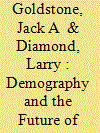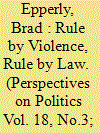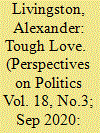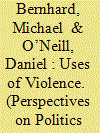|
|
|
Sort Order |
|
|
|
Items / Page
|
|
|
|
|
|
|
| Srl | Item |
| 1 |
ID:
174467


|
|
|
|
|
| Summary/Abstract |
Violence against women in politics is increasingly recognized around the world as a significant barrier to women’s political participation, following a troubling rise in reports of assault, intimidation, and abuse directed at female politicians. Yet conceptual ambiguities remain as to the exact contours of this phenomenon. In this article, we seek to strengthen its theoretical, empirical, and methodological foundations. We propose that the presence of bias against women in political roles—originating in structural violence, employing cultural violence, and resulting in symbolic violence—distinguishes this phenomenon from other forms of political violence. We identify five types of violence against women in politics—physical, psychological, sexual, economic, and semiotic—and three methodological challenges related to underreporting, comparing men’s and women’s experiences, and intersectionality. Inspired by the literature on hate crimes, we develop an empirical approach for identifying cases of violence against women in politics, offering six criteria to ascertain whether an attack was potentially motivated by gender bias. We apply this framework to analyze three cases: the assassination of Benazir Bhutto, the impeachment of Dilma Rousseff, and the murder of Jo Cox. We conclude with the negative implications of violence against women in politics and point to emerging solutions around the globe.
|
|
|
|
|
|
|
|
|
|
|
|
|
|
|
|
| 2 |
ID:
174475


|
|
|
|
|
| Summary/Abstract |
The world is in the midst of a demographic recession. This counters what should be a long-term trend toward greater democracy. Recent research has shown that progress toward stable democracy is strongly associated with progress in the demographic transition. Since most of the world is rapidly dropping in fertility as more countries complete this transition, democracy should be spreading. However, a resurgence of anxiety, nationalism, and support for strong-man governance is associated with sudden waves of immigration from unfamiliar sources. Because certain parts of the world—mainly Central America, sub-Saharan Africa, and the Middle East—still have very young and rapidly growing populations who suffer from poor economic prospects, adverse climate change, and bad governance, those regions are sending waves of migrants seeking asylum to Europe and the United States, raising anxieties that undermine liberal democratic governance. Global democracy is thus being tugged in opposing directions by current demographic trends. Improving governance in poorer countries to cope with the negative impact of climate change and to create better economic prospects, as well as efforts to reduce fertility, are essential to diminish the surges of migrants and restore the impetus toward democracy that should prevail in mature societies.
|
|
|
|
|
|
|
|
|
|
|
|
|
|
|
|
| 3 |
ID:
174469


|
|
|
|
|
| Summary/Abstract |
Over the last two decades alone, the United States has suffered well over ten thousand religion-motivated hate crimes. While racism and religion-motivated prejudice have received considerable attention following the “Unite the Right” rally in Charlottesville that resulted in deadly violence, there is little systematic scholarship evaluating where and when incidents targeting ethnoreligious minorities by non-state actors are likely to occur. Utilizing the FBI’s reported anti-Semitic hate crime data from 2001–2014, my main theoretical and empirical exercise is to determine which factors best explain where and when American ethnoreligious groups are likely to be targeted. I propose that there are four essential mechanisms necessary to explain variation in minority targeting: “opportunity” (target group concentration), “distinguishability” (target group visibility), “stimuli” (events increasing target group salience) and “organization” (hate group quantity). My models show that variables falling within each of these theoretical concepts significantly explain variation in anti-Semitic incidents in the United States. Of particular importance for scholars and practitioners alike, Israeli military operations and the number of active hate groups within a state play a major role in explaining anti-Semitic incident variation.
|
|
|
|
|
|
|
|
|
|
|
|
|
|
|
|
| 4 |
ID:
174466


|
|
|
|
|
| Summary/Abstract |
Violent movements in different parts of the world have employed large numbers of women fighters. I address the question of how and why so many women from diverse backgrounds join an ethnic insurgency. Informed by an intersectional approach, I suggest that when gender and ethnic inequalities overlap, an ethnic insurgency promising gender emancipation would have strong appeal among women. At the same time, the intersection of class and gender shapes distinctive patterns of mobilization among women of an ethnic minority. In particular, uneducated women with lower class backgrounds join the movement because it provides them with the most viable way out of patriarchal relations. I employ a multi-method research design to study a paradigmatic case of women in arms, the Kurdish insurgency. I use an original large dataset containing information about more than 9,000 militants, from extensive fieldwork entailing dozens of in-depth interviews, and an archival study of sources in primary languages. My findings reveal the effects of unequal relationships based on ethnicity, gender, and class on violent political mobilization and the ambivalent relationship between women’s political agency and empowerment.
|
|
|
|
|
|
|
|
|
|
|
|
|
|
|
|
| 5 |
ID:
174465


|
|
|
|
|
| Summary/Abstract |
The conventional approach to criminal victimization views it as a traumatic but one-time act. This overlooks a layer of contentious and dynamic politics between victims and criminal actors that we have yet to analyze. I develop a new theoretical framework to analyze the strategic behaviors that victims and criminal actors use to pursue and resist power as part of the political process of criminal victimization. The framework enables us to better observe, conceptualize, and theorize how victims exercise agency vis-à-vis their criminal perpetrators, as well as behaviors and practices that criminal actors undertake to carry out and sustain victimization, but which are overlooked by the traditional focus on their use and threat of coercive force. I illustrate the framework’s analytic utility with an empirical analysis of the victimization of informal street vendors in a major Latin American city under a criminal protection racket. The argument and empirical findings suggest ways to expand and deepen the research agenda on the politics of criminal victimization.
|
|
|
|
|
|
|
|
|
|
|
|
|
|
|
|
| 6 |
ID:
174470


|
|
|
|
|
| Summary/Abstract |
In 2010 Colombia experienced an unexpected surge in acid attacks against women, and from 2010–2014, it had more acid attacks per capita than any other country in the world. No other form of violent crime in the country demonstrated such a spike. What explains this unusual variation in violence? I argue that this unique pattern of violence was made sensible by the 2005–2011 nation-building campaign Colombia Is Passion that redefined the enduring violence plaguing the country as men’s misunderstood passion for beautiful women. By valorizing violence toward women and making women’s membership in the nation contingent upon their beauty, the campaign created an affective economy under which acid attacks became both intelligible and effective in producing social death and national ostracization. In this paper, I have denaturalized violence against women and suggest that political scientists might do more to explain important variations of violence outside of armed conflict. Finally, I demonstrate the explanatory power of interpretive studies of political culture, national identity, and public emotion in structuring the meaning and patterns of violence.
|
|
|
|
|
|
|
|
|
|
|
|
|
|
|
|
| 7 |
ID:
174471


|
|
|
|
|
| Summary/Abstract |
What is political knowledge? We argue that the traditional measure of political knowledge is limited, as it represents one domain of facts that people should know about American politics. This domain of knowledge is rooted in the liberal-democratic face of the state and neglects other political knowledge generated from the carceral face of the state. We argue that knowledge of carceral violence, especially against African Americans, represents a separate domain of knowledge that is particularly relevant to marginalized communities, especially black youth. Once we include carceral violence in our measures of political knowledge, established patterns of whites having more political knowledge than Blacks are reversed. Using a novel measurement strategy and based on a nationally representative survey of over 2,000 young people, we find that knowledge of carceral violence is distinct from measures of what has been called general political knowledge. Finally, we find that knowledge of carceral violence has distinct correlates from the standard knowledge battery and its relationship to political participation varies by racial group but tends to depress the political participation of African Americans. Our findings raise the question of what comprises relevant and important political knowledge today and for which communities.
|
|
|
|
|
|
|
|
|
|
|
|
|
|
|
|
| 8 |
ID:
174468


|
|
|
|
|
| Summary/Abstract |
Although restricting formal voting rights—voter suppression—is not uncommon in democracies, its incidence and form vary widely. Intuitively, when competing elites believe that the benefits of reducing voting by opponents outweigh the costs of voter suppression, it is more likely to occur. Internal political and state capacity and external actors, however, influence the form that voter suppression takes. When elites competing for office lack the ability to enact laws restricting voting due to limited internal capacity, or external actors are able to limit the ability of governments to use laws to suppress voting, suppression is likely to be ad hoc, decentralized, and potentially violent. As political and state capacity increase and external constraints decrease, voter suppression will shift from decentralized and potentially violent to centralized and mostly non-violent. We illustrate our arguments by analyzing the transition from decentralized, violent voter suppression through the use of lynchings (and associated violence) to the centralized, less violent suppression of black voting in the post-Reconstruction South. We also place the most recent wave of U.S. state voter suppression laws into broader context using our theoretical framework.
|
|
|
|
|
|
|
|
|
|
|
|
|
|
|
|
| 9 |
ID:
174472


|
|
|
|
|
| Summary/Abstract |
Lynch mobs regularly called on the language of popular sovereignty in their efforts to authorize lynchings, arguing that, as representatives of the people, they retained the right to wield public violence against persons they deemed beyond the protections of due process. Despite political theorists’ renewed interest in popular sovereignty, scholars have not accounted for this sordid history in their genealogies of modern democracy and popular constituent power. I remedy this omission, arguing that spectacle lynchings—ones that occurred in front of large crowds, sometimes numbering in the thousands—operated as public rituals of racialized people-making. In the wake of Reconstruction, when the boundaries of the polity were deeply contested, spectacle lynchings played a constitutive role in affirming and circulating the notion that the sovereign people were white, and that African Americans were their social subordinates.
|
|
|
|
|
|
|
|
|
|
|
|
|
|
|
|
| 10 |
ID:
174474


|
|
|
|
|
| Summary/Abstract |
Love is a key concept in the theory and history of civil disobedience yet it has been purposefully neglected in recent debates in political theory. Through an examination of Martin Luther King, Jr.’s paradoxical notion of “aggressive love,” I offer a critical interpretation of love as a key concept in a vernacular black political theology, and the consequences of love’s displacement by law in liberal theories of civil disobedience. The first section locates the origins of aggressive love in an earlier generation of black theologians who looked to India’s anticolonial struggle to reimagine the dignity of the oppressed as “creative survival.” The second contextualizes King’s early sermons on moral injury and self-respect within this tradition to reinterpret Stride toward Freedom’s account of the dignity-enhancing effects of nonviolent resistance as the triumph of love over fear. The third considers the implications of these arguments for conceptualizing the moral psychology of the white citizen and its consequences for contemporary debates over the ideological uses of Civil Rights history. The call to respond to oppression with aggressive love illustrates the paradoxical character of civil disobedience obscured by legal accounts as well as by criticisms of the very idea of “civil” disobedience. This is the paradox of affirming civility while enacting disobedience in order to bind political confrontation with political pedagogy.
|
|
|
|
|
|
|
|
|
|
|
|
|
|
|
|
| 11 |
ID:
174464


|
|
|
| 12 |
ID:
174473


|
|
|
|
|
| Summary/Abstract |
Roughly half of the U.S. public thinks that torture can be acceptable in counterterrorism. According to recent research, dramatic depictions of torture increase public support for the practice. Yet we do not know how frequently—and in what context—torture is depicted across popular media. What messages about the acceptability and effectiveness of torture do Americans receive when they watch popular films? To address this question, we coded each incident of torture in the twenty top-grossing films each year from 2008 to 2017 to analyze how torture is portrayed in terms of its frequency, efficacy, and social acceptability. Results show that the majority of popular films—including films aimed toward children—have at least one torture scene. Across films, the messages sent about torture are fairly consistent. As expected, movies tend to depict torture as effective. Further, how movies portray torture is also a function of who is perpetrating it. Specifically, protagonists are more likely to torture for instrumental reasons or in response to threats and are more likely to do so effectively. In contrast, antagonists are more likely to use torture as punishment and to torture women. The frequency and nature of torture’s depiction in popular films may help explain why many in the public support torture in counterterrorism.
|
|
|
|
|
|
|
|
|
|
|
|
|
|
|
|
|
|
|
|
|